By Gerald L. Maatman, Jr., Alex W. Karasik, Jennifer A. Riley, and George J. Schaller
Duane Morris Takeaways: In FY 2024 (October 1, 2023 to September 30, 2024), the EEOC’s litigation enforcement activity showed a notable decrease in filings in a year of transition for America. But with an uncertain election season in November 2024, the EEOC’s onslaught of September filings demonstrates the Agency’s principled approach to thwart discrimination in the workplace.
Although the total number of lawsuits filed by the EEOC decreased from 144 in 2023 to 110 in FY 2024, the EEOC’s targeted efforts involve a bevy of September filings concerning discrimination allegations against employers across a myriad of industries. Each year, the EEOC’s fiscal year ends on September 30, and the final sprint for EEOC-initiated litigation in September 2024 aligned with prior “last-month” enforcement efforts. This year, 67 lawsuits were filed in September, equal to the 67 filed in September of FY 2023.
Overall, the FY 2024 lawsuit filing data confirms that EEOC litigation continues its steady path in enforcement efforts. While total filings were down, Employers must recognize the key areas the EEOC continued its litigation including by industry and filing type. Employers must maintain legal compliance with all EEOC initiatives and this FY 2024 synopsis offers insights into year-over-year EEOC enforcement patterns.
Lawsuit Filings Based On Month
We track the EEOC’s filing efforts across the entire fiscal year with its beginning in October through the anticipated final filings in September. As with other fiscal years, the EEOC’s filing patterns remained consistent through June 2024, with a slight increase in July 2024, another slight increase in August 2024, and significant jump in September 2024. Of the 110 total filings this year, more than half – 67 total – were filed in September. The following chart shows the EEOC’s filing pattern over FY 2024:
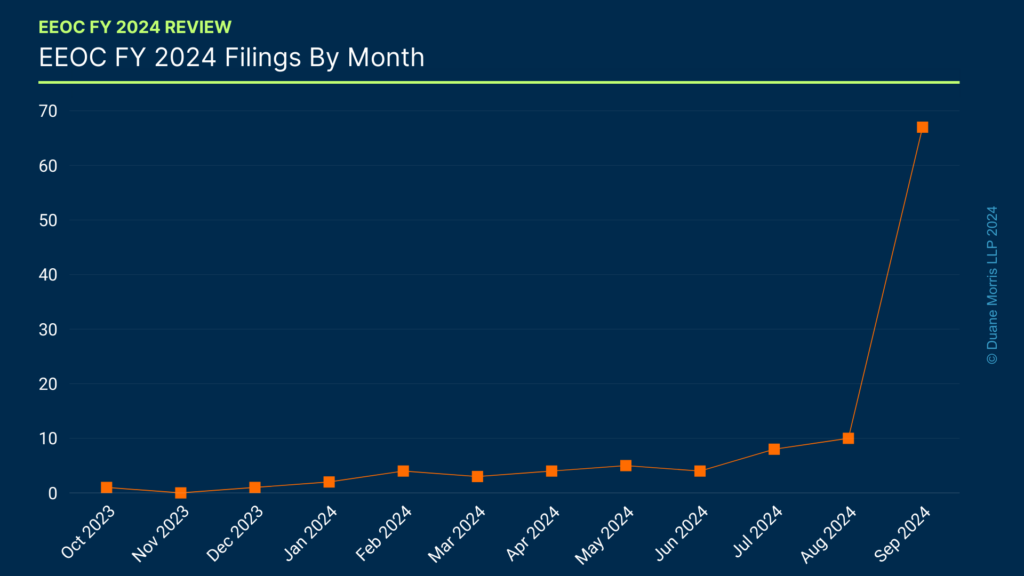
Comparing these fiscal filings in FY 2024 to previous years, a significant decrease exists from FY 2023 (144 lawsuits), which was an outlier in terms of EEOC litigation in the post-COVID era. The following graph shows the EEOC’s year-over-year fiscal year filings beginning in FY 2017 through FY 2024:
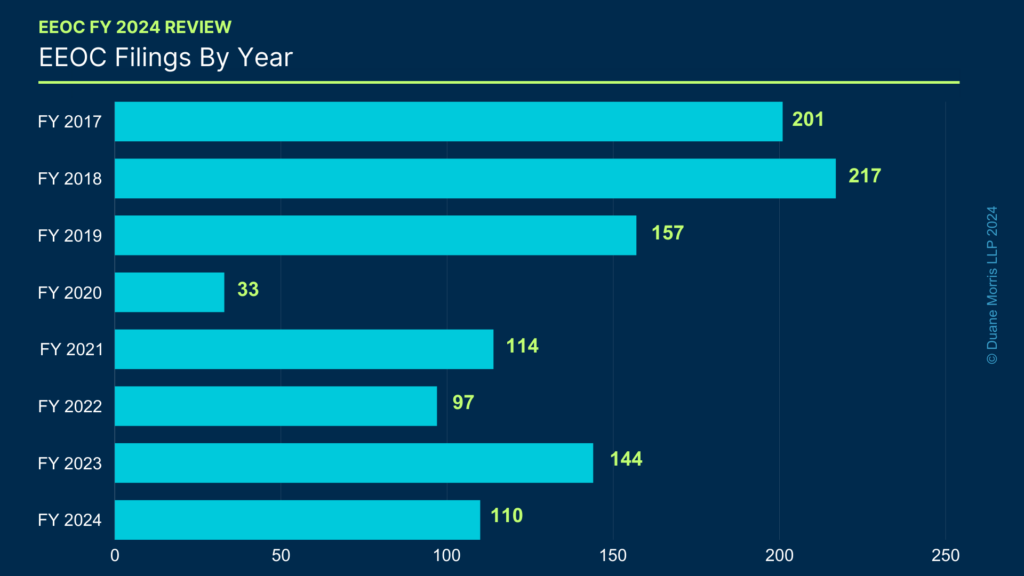
Lawsuit Filings Based On EEOC District Offices
In addition to tracking the total number of filings, we closely monitor which of the EEOC’s 15 district offices are most actively filing new cases over the year and throughout September. Some district offices tend to be more aggressive than others, and some focus on different case filing priorities. The following chart shows the number of lawsuit filings by each of the EEOC district offices.
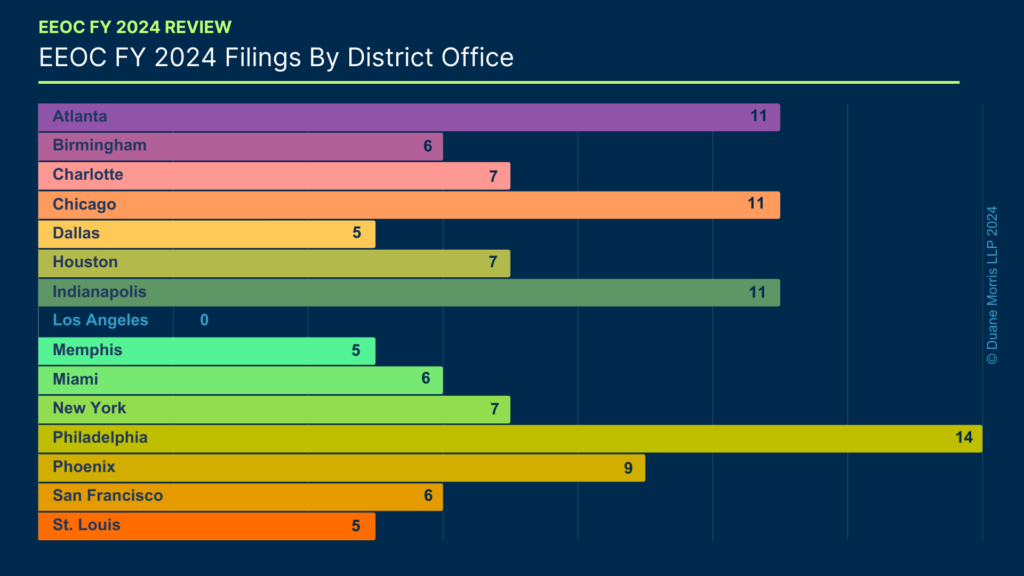
In FY 2024, Philadelphia had the most filings with 14, followed by Atlanta, Chicago, and Indianapolis with 11 each, followed by Phoenix with 9 filings, Charlotte, Houston, and New York with 7 each, and Birmingham, Miami, and San Francisco with 6 filings each. Dallas, Memphis, and St. Louis had 5 filings. Notably, Los Angeles had no filings.
While filings across the board were down, the most noticeable trend of FY 2024 is the filing jump in Atlanta (11 lawsuits), compared to FY 2023 where Atlanta had 9 fillings. In contrast, Philadelphia had a significant decrease in filings (14 lawsuits), compared to FY 2023 where Philadelphia amassed 19 filings. Like FY 2023, Chicago and Indianapolis remained steady near the top of the list again with 11 filings each, down from the 13 filings both districts launched in FY 2023. On the opposite end of the spectrum, New York filings (7 lawsuits) fell slightly compared to its 10 filings in FY 2023, and Los Angeles (0 lawsuits) significantly fell compared to its 10 filings in FY 2023.
Although filing trends were down for all Districts, the 110 total filings demonstrate the EEOC maintained its litigation strength, both at the national and regional level.
Lawsuit Filings Based On Type Of Discrimination
We also analyze the types of lawsuits the EEOC filed, in terms of the statutes and theories of discrimination alleged, in order to determine how the EEOC is shifting its strategic priorities.
When considered on a percentage basis, the distribution of cases filed by statute remained roughly consistent compared to FY 2024 and FY 2023. Title VII cases once again made up the majority of cases filed, as they constituted 61% of all filings in FY 2024 (significantly down from 68% of all filings FY 2023, down from the 69% filings in FY 2022, and equal to 61% in FY 2021).
Overall ADA cases also made up a significant percentage of the EEOC’s FY 2024 filings – totaling 41%. This is an overall increase in previous years where ADA filings amounted to 34% in FY 2023, 29.7% in FY 2022, and just below the 37% in FY 2021.
There was also a downward trend in ADEA filings, as 7 ADEA cases were filed in FY 2024, after 12 age discrimination cases were filed in FY 2023 and 7 age discrimination cases filed in FY 2022. However, unlike FY 2023, this year the EEOC filed 4 Pregnant Worker’s Fairness Act cases (“PWFA”) after the PWFA went into effect on June 27, 2023.
The first graph below shows the number of lawsuits filed according to the statute under which they were filed (Title VII, Americans With Disabilities Act, Pregnancy Discrimination Act, Equal Pay Act, Age Discrimination in Employment Act, Pregnant Worker’s Fairness Act, and Genetic Information Nondiscrimination Act) and, the second graph, shows the basis of discriminatory allegations.
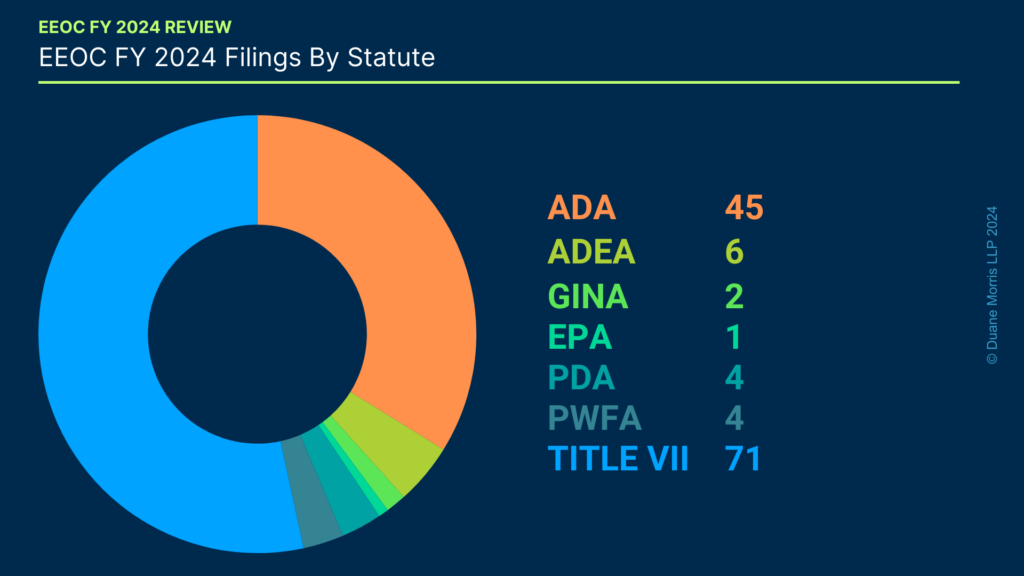
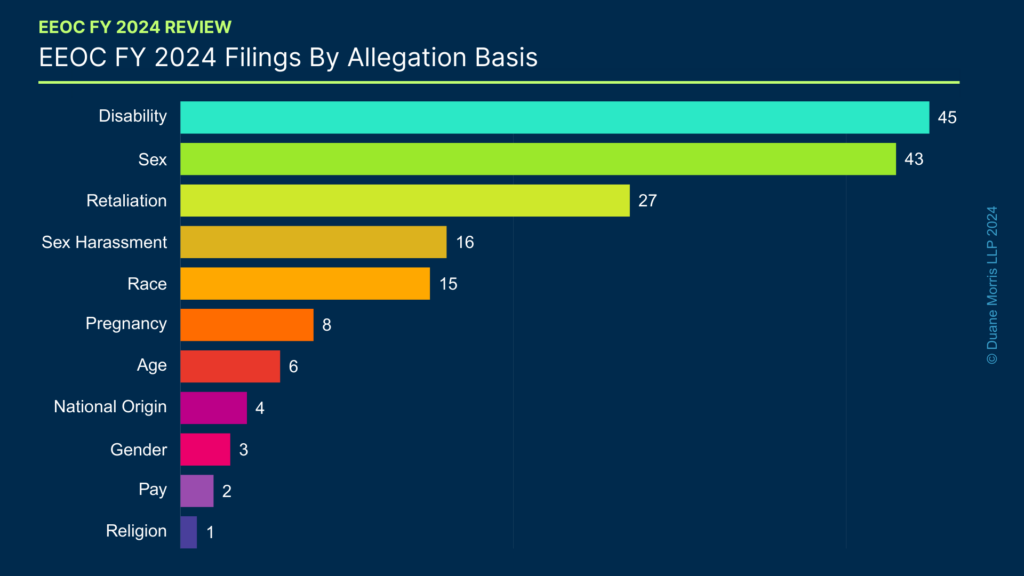
Lawsuits Filings Based On Industry
In monitoring the EEOC’s filings by industry, FY 2024 has mirrored EEOC-initiated lawsuits in the top three industries compared to FY 2023, demonstrating the Commission’s focus on a few major industries.
Three industries were the primary targets of lawsuit filings in FY 2024: Hospitality (Restaurants / Hotels / Entertainment) with 23 filings, Healthcare with 22 filings, and Retail with 21 filings. The next set of industries did not amount to double-digit filings, but are still well within the EEOC’s sights, including Manufacturing with 11 filings; Logistics with 7 filings; Construction with 4 filings; and Property Management with 3 filings.
This aligns with FY 2023, where Hospitality (mainly Restaurants) was the industry at large with 28 filings. Again in second and third place were Retail and Healthcare, respectively, with 24 filings. Absent from FY 2024’s industry-based filings were Automotive, Security, and Technology.
Like FY 2023, Hospitality, Retail, and Healthcare employers should continue to monitor their compliance with federal discrimination laws, as the EEOC continues its enforcement against these industries for alleged discriminatory practices. The industries are regular hotbeds for charges and ultimately lawsuits. No matter the industry, every employer should recognize they are vulnerable to EEOC-initiated litigation as detailed by the below graph.
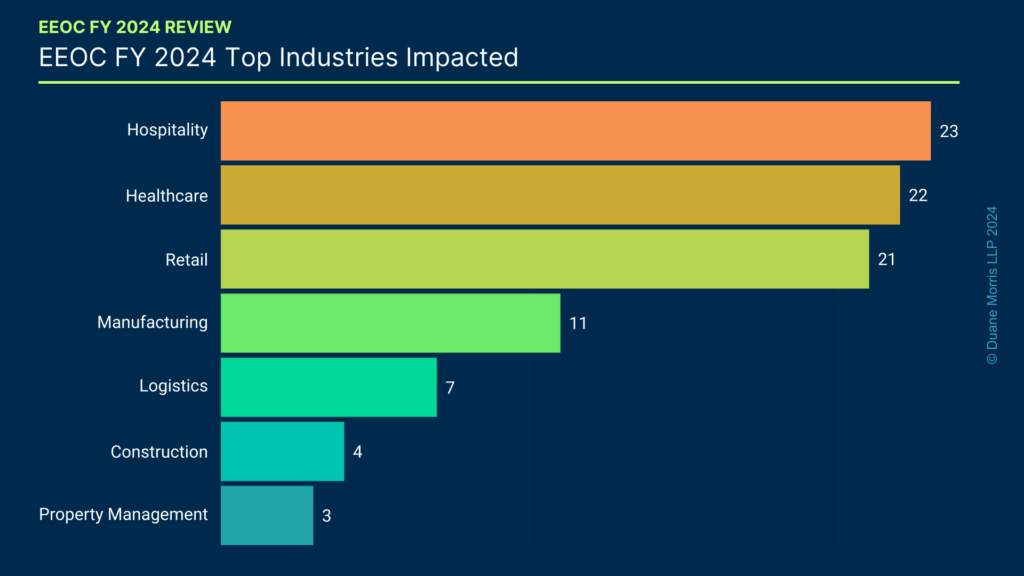
Looking Ahead To Fiscal Year 2025
Moving into FY 2025, the EEOC’s budget includes a $33.221 million increase from 2024, and prioritizes five key areas, including advancing racial justice and combatting systemic discrimination on all protected bases, particularly with respect to vulnerable workers; advancing pay equity; addressing the use of artificial intelligence in employment decisions; providing information to assist employers that chose to undertake lawful approaches to fostering diversity, equity, inclusion, and accessibility (DEIA) in their workplaces; and preventing unlawful retaliation and harassment.
The EEOC also maintained its FY 2024 goals for its own Diversity, Equity, Inclusion, and Accessibility (DEIA) program where it seeks to achieve four goals, including workplace diversity, employee equity, inclusive practices, and accessibility. Additionally, the EEOC continues to emphasize and build upon its FY 2021 software initiatives addressing artificial intelligence, machine learning, and other emerging technologies in continued efforts to provide guidance. The EEOC notably recognized that AI systems may offer new opportunities for employers but cautioned AI’s potential to facilitate discrimination. Finally, the joint anti-retaliation initiative among the EEOC, the U.S. Department of Labor, and the National Labor Relations Board will continue to address retaliation in American workplaces.
Key Employer Takeaways
In many respects, FY 2024 was a year of targeted enforcement and continued efforts across several discriminatory areas, even if total filings decreased overall. The EEOC again requested a significant budget increase for its enforcement efforts, and the EEOC’s focus on emerging technologies juxtaposed with discrimination warrants employer recognition. As election season is approaching, the EEOC’s FY 2024 represents the current presidency’s enforcement goals and the Agency’s efforts to combat all areas of discrimination. We anticipate these figures will grow by next year’s report, so it is more crucial than ever for employers to comply with discrimination laws.

